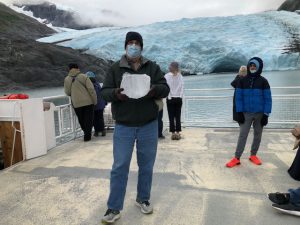
That’s me, holding a piece of a glacier, in front of a glacier. It was one of several stunning moments from the Alaskan adventure my wife and I just returned from.
The planning started in April, right after we’d received our second doses of the Pfizer vaccine. We knew we wanted to travel again, but most of the international destinations we had in mind still weren’t allowing Americans in. So, we thought, where can we have an exotic vacation without leaving the USA? That’s when Alaska jumped to the front of our list.
When we told our friends, they all assumed we’d be going on a cruise up the Inside Passage. But we’re not cruise people, so we put together an inland itinerary, with lots of interesting things to do and see along the way. Let me tell you about a few of them.
The day after we arrived, we boarded a small float plane with veteran bush pilot Jerry at the helm as we took off from Lake Flood. It’s the largest float plane base in the world, with hundreds of flights per day, all taking off and landing on water, a first for us. Jerry flew us to a lodge at the base of Redoubt Mountain, an active volcano which last blew its top in 2009. It’s in Lake Clark National Park, the third-least-visited in the entire national park system. Why? Because there are no roads — you have to fly in. That’s not unusual in Alaska, where a mere 10% of the state has paved roads, there are only seven highways, and a third of the population gets around in prop planes.
At Redoubt, we boarded a launch driven by a 24-year-old woman named Rey, who took us around Lake Crescent, a beautiful nine-mile-long body of water in the shadow of some fantastic scenery, looking for coastal brown bears. Over the course of several hours, we spotted a dozen of them, sometimes a Mama Bear with two or three cubs, sometimes a solo bear wandering along the water’s edge looking for salmon. Those bears eat about a hundred pounds of salmon daily, but because they’re constantly moving, they only gain about three pounds a day. Rey told us that she and the other 14 people who keep the lodge running all summer also eat salmon daily, caught in that very lake. Not being seafood lovers, Martha and I took the other option, veggie burgers, when it was lunch time.
After we ate, we were back on the launch to view more bears in other spots around the lake. We were fascinated watching the animals loping along, then diving into the water and coming up with salmon. Oh, and while Mama Bear does nurse her youngest cubs, when they get a bit older she doesn’t catch the fish for them — they’re expected to watch, learn, and feed themselves. We were also taken with inhaling the crisp, clean air at the lake, a sensation we reveled in at many of the venues we visited in the following week. I was also awed looking into the distance and seeing only wilderness, with (except for the four women on the boat with me) not a single human being to be found.
At the end of the day, another bush pilot named Kyle flew us back, pointing out a pod of about a hundred seals on a sand bar and a couple of beluga whales in Cook Inlet. While the seals were easy to spot, we had to take his word about the belugas, which looked to us like small white dots on the water, completely unidentifiable from 600 feet in the air.
The next day, we endured an eight-hour Alaska Railroad ride north to Denali National Park, home of the tallest mountain in North America. The first half of the trip didn’t offer much in terms of scenery because the tracks are flanked by trees. In fact, the only highlight of that portion was when we passed the town of Wasilla and I gave it the finger, only to learn later that Sarah Palin had long ago moved to Arizona.
The second half of the train trip revealed beautiful hillsides, rivers, and wide open spaces, yet I was surprised to discover it is possible to become bored of seeing mountains. I was reminded of when we went to Yellowstone a few years ago and were thrilled the first few times we saw bison. But by the third day, they were old news, and we didn’t even bother photographing them anymore. The same attitude applied to the big, brown mountain ranges we passed.
We had been looking forward to going on the Tundra Wilderness Tour inside Denali National Park, which turned out to be essentially a bus ride along it only road — and because of a landslide a few days before we arrived, we could only go about 30 miles, a third of the way across. To make matters worse, we didn’t see any grizzlies, moose, or any wildlife other than a herd of caribou grazing on a hillside. As for the tundra, like the bison and mountains, it got old pretty quickly.
The good news was the weather had been perfect thus far, even clear enough to see the 20,000-foot peak of Denali, which we learned only about 30% of visitors ever witness because of the weather. The bad news was that the nearest we got to the big mountain on the bus ride was 60 miles away, not exactly close enough for a great picture with the zooming capabilities of our iPhones.
But that vantage point improved greatly a couple of days later when our guide drove us south to the village of Talkeetna, which seemed to be not much more than a tourist trap with muddy streets and too many gift shops. But that’s where we went on a jet boat adventure up the Susitna River (15th longest in the US), with a stop to learn about the hunting and fishing cultures of Alaskan Native people — as told by Eli and Abby, the Natives who steered the boat and provided running commentary.
That was topped later that afternoon when we were back in a small propeller plane, piloted by LeeAnn, who took us to see Denali up close. Really close. Filling up the entire view from the window of the plane close. Even better, though we had taken off with wheels on the airport tarmac, the plane also had skis, which allowed her to set us down in a gigantic gorge on the nearby Ruth Glacier, which has an ice base a thousand feet deep. Fortunately, there’s hundred-foot-deep snow on top, which made for a softer landing.
And that’s when we got out of the plane and walked on the glacier! Looking around at the jagged mountainside that surrounded us, it felt like we were on an alien world. I turned to my wife and said, “Can you believe this?” She replied, “I have no words.” Neither did I, so I did the only logical thing: I hit her in the leg with a glacial snowball. She shook it off and we spent about a half-hour just gazing around in awe.
That was our first experience with a glacier, but not our last. Two days later, we went south past Turnagain Arm to Chugach National Forest, where we boarded yet another boat and crossed a lake to see the Portage Glacier. Unlike the Ruth Glacier, Portage had a distinct blue tint. The captain hoped we’d get to see some of the ice calving at the water’s edge. We had no luck there, but did see the icebergs that remained from a calving event two days earlier. The crew had picked up some of that ice and had it on board, which is how it ended up in my hands for the photo above — giving me yet another mind-blowing memory from this amazing adventure.
I could go on telling stories from this trip for a long time, but I’ll stop here. Suffice to say that while we felt a little odd carrying our warm winter gear when we boarded the plane to leave St. Louis and start our Alaskan week, we happily traded in the ninety-degree humid days of home for the landscapes and vistas of The Last Frontier.
